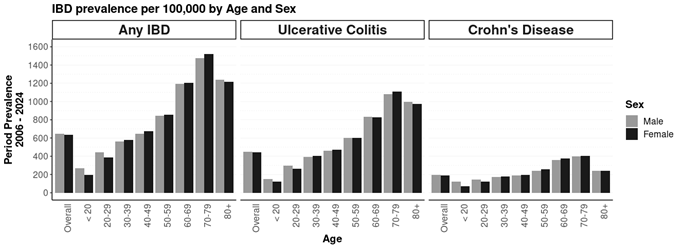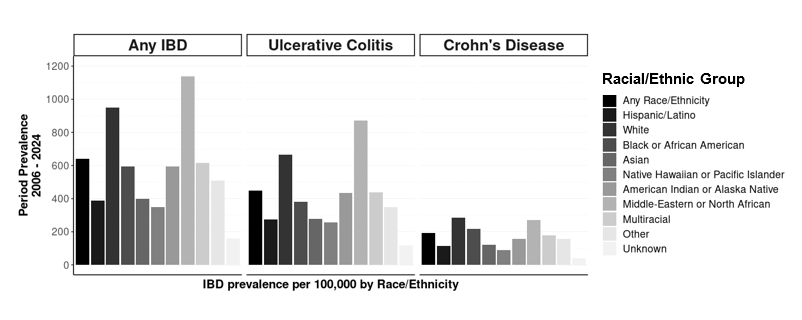Monday Poster Session
Category: IBD
P3215 - Racial/Ethnic Prevalence of Inflammatory Bowel Disease in a Community-Based Integrated Healthcare System in Northern California
Monday, October 27, 2025
10:30 AM - 4:00 PM PDT
Location: Exhibit Hall

Catalina Mulanax, MD, BA
Kaiser Permanente
San Francisco, CA
Presenting Author(s)
Catalina Mulanax, MD, BA, Fernando Velayos, MD, Mahim Naveed, MS
Kaiser Permanente, San Francisco, CA
Introduction: Over three million individuals in the United States (US) live with inflammatory bowel disease (IBD), which includes two main subtypes of ulcerative colitis (UC) and Crohn’s disease (CD). Although IBD has historically been understood to predominantly affect White populations of European descent, demographic shifts over the past five decades have increased the proportion of non-White racial and ethnic groups in the US. However, data on the prevalence of IBD in the US, particularly among non-White and Native populations, remain limited. This is partly due to the lack of healthcare systems with comprehensive data, insufficiently granular race/ethnicity data, and the absence of established cohorts representing diverse populations.
Methods: We estimated the prevalence of UC and CD between 2006 and 2024 within a diverse, community-based integrated healthcare system in Northern California that serves over 4.5 million members across numerous medical centers and hospitals. The demographics of this healthcare system are comparable to the broader population of insured patients in the region. After receiving IRB approval, we used previously validated combinations of medical diagnoses and prescription medications to identify prevalent IBD cases. We calculated crude prevalence per 100,000 population by age, sex, and race/ethnicity and computed 95% confidence intervals (CI).
Results: The overall prevalence of IBD was 640 per 100,000 population (95% CI: 635-647). The prevalence was similar between men and women and increased with age (Figure 1). The prevalence of IBD per 100,000 population was 951 (95% CI: 940-962) in White; 596 (95% CI: 573-619) in Black; 399 (95% CI: 388-410) in Asian; 388 (95% CI:376-400) in Hispanic/Latino; 594 (95% CI: 504-696) in American Indian or Alaska Native; 348 (95% CI: 299-402) in Native Hawaiian or Pacific Islander; and 1140 (95% CI: 892-1435) in Middle Eastern or North African members (Figure 2).
Discussion: Prevalence was highest among Middle Eastern/North African members, followed by White, Black, American Indian/Alaska Native, Asian, Hispanic/Latino, and Native Hawaiian/Pacific Islander members. Studying IBD by race and ethnicity not only unravels the genetic and environmental underpinnings of IBD but also informs the need for tailored approaches to care for all members.

Figure: Prevalence by age group per 100,000 members for any inflammatory bowel disease, ulcerative colitis, and Crohn's disease stratified by sex.

Figure: Racial/ethnic-specific prevalence per 100,000 members for any inflammatory bowel disease, ulcerative colitis, and Crohn's disease.
Disclosures:
Catalina Mulanax indicated no relevant financial relationships.
Fernando Velayos indicated no relevant financial relationships.
Mahim Naveed indicated no relevant financial relationships.
Catalina Mulanax, MD, BA, Fernando Velayos, MD, Mahim Naveed, MS. P3215 - Racial/Ethnic Prevalence of Inflammatory Bowel Disease in a Community-Based Integrated Healthcare System in Northern California, ACG 2025 Annual Scientific Meeting Abstracts. Phoenix, AZ: American College of Gastroenterology.
Kaiser Permanente, San Francisco, CA
Introduction: Over three million individuals in the United States (US) live with inflammatory bowel disease (IBD), which includes two main subtypes of ulcerative colitis (UC) and Crohn’s disease (CD). Although IBD has historically been understood to predominantly affect White populations of European descent, demographic shifts over the past five decades have increased the proportion of non-White racial and ethnic groups in the US. However, data on the prevalence of IBD in the US, particularly among non-White and Native populations, remain limited. This is partly due to the lack of healthcare systems with comprehensive data, insufficiently granular race/ethnicity data, and the absence of established cohorts representing diverse populations.
Methods: We estimated the prevalence of UC and CD between 2006 and 2024 within a diverse, community-based integrated healthcare system in Northern California that serves over 4.5 million members across numerous medical centers and hospitals. The demographics of this healthcare system are comparable to the broader population of insured patients in the region. After receiving IRB approval, we used previously validated combinations of medical diagnoses and prescription medications to identify prevalent IBD cases. We calculated crude prevalence per 100,000 population by age, sex, and race/ethnicity and computed 95% confidence intervals (CI).
Results: The overall prevalence of IBD was 640 per 100,000 population (95% CI: 635-647). The prevalence was similar between men and women and increased with age (Figure 1). The prevalence of IBD per 100,000 population was 951 (95% CI: 940-962) in White; 596 (95% CI: 573-619) in Black; 399 (95% CI: 388-410) in Asian; 388 (95% CI:376-400) in Hispanic/Latino; 594 (95% CI: 504-696) in American Indian or Alaska Native; 348 (95% CI: 299-402) in Native Hawaiian or Pacific Islander; and 1140 (95% CI: 892-1435) in Middle Eastern or North African members (Figure 2).
Discussion: Prevalence was highest among Middle Eastern/North African members, followed by White, Black, American Indian/Alaska Native, Asian, Hispanic/Latino, and Native Hawaiian/Pacific Islander members. Studying IBD by race and ethnicity not only unravels the genetic and environmental underpinnings of IBD but also informs the need for tailored approaches to care for all members.

Figure: Prevalence by age group per 100,000 members for any inflammatory bowel disease, ulcerative colitis, and Crohn's disease stratified by sex.

Figure: Racial/ethnic-specific prevalence per 100,000 members for any inflammatory bowel disease, ulcerative colitis, and Crohn's disease.
Disclosures:
Catalina Mulanax indicated no relevant financial relationships.
Fernando Velayos indicated no relevant financial relationships.
Mahim Naveed indicated no relevant financial relationships.
Catalina Mulanax, MD, BA, Fernando Velayos, MD, Mahim Naveed, MS. P3215 - Racial/Ethnic Prevalence of Inflammatory Bowel Disease in a Community-Based Integrated Healthcare System in Northern California, ACG 2025 Annual Scientific Meeting Abstracts. Phoenix, AZ: American College of Gastroenterology.
